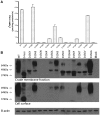Functional roles of aspartate residues of the proton-coupled folate transporter (PCFT-SLC46A1); a D156Y mutation causing hereditary folate malabsorption
- PMID: 20805364
- PMCID: PMC3012536
- DOI: 10.1182/blood-2010-06-291237
Functional roles of aspartate residues of the proton-coupled folate transporter (PCFT-SLC46A1); a D156Y mutation causing hereditary folate malabsorption
Abstract
The proton-coupled folate transporter (PCFT; SLC46A1) mediates folate transport into enterocytes in the proximal small intestine; pcft loss-of-function mutations are the basis for hereditary folate malabsorption. The current study explored the roles of Asp residues in PCFT function. A novel, homozygous, loss-of-function mutation, D156Y, was identified in a child of Pakistani origin with hereditary folate malabsorption. Of the 6 other conserved Asp residues, only one, D109, is shown to be required for function. D156Y, along with a variety of other substitutions at this site (Trp, Phe, Val, Asn, or Lys), lacked function due to instability of the PCFT protein. Substantial function was preserved with Glu, Gly, and, to a lesser extent, with Ser, Thr, and Ala substitutions. This correlated with PCFT bio-tinylated at the cell surface. In contrast, all D109 mutants, including D109E, lacked function irrespective of pH (4.5, 5.5, and 7.4) or substrate concentration (0.5-100 μM), despite surface expression comparable to wild-type PCFT. Hence, D156 plays a critical role in PCFT protein stability, and D109, located in the first intracellular loop between the second and third transmembrane domains, is absolutely required for PCFT function.
Figures







Comment in
-
ABC of D's in the folate transporter.Blood. 2010 Dec 9;116(24):5082-3. doi: 10.1182/blood-2010-09-306381. Blood. 2010. PMID: 21148336 No abstract available.
Similar articles
-
Functional roles of the A335 and G338 residues of the proton-coupled folate transporter (PCFT-SLC46A1) mutated in hereditary folate malabsorption.Am J Physiol Cell Physiol. 2012 Oct 15;303(8):C834-42. doi: 10.1152/ajpcell.00171.2012. Epub 2012 Jul 25. Am J Physiol Cell Physiol. 2012. PMID: 22843796 Free PMC article.
-
A novel deletion mutation in the proton-coupled folate transporter (PCFT; SLC46A1) in a Nicaraguan child with hereditary folate malabsorption.Gene. 2013 Sep 25;527(2):673-4. doi: 10.1016/j.gene.2013.06.039. Epub 2013 Jun 28. Gene. 2013. PMID: 23816405 Free PMC article.
-
Properties of the Arg376 residue of the proton-coupled folate transporter (PCFT-SLC46A1) and a glutamine mutant causing hereditary folate malabsorption.Am J Physiol Cell Physiol. 2010 Nov;299(5):C1153-61. doi: 10.1152/ajpcell.00113.2010. Epub 2010 Aug 4. Am J Physiol Cell Physiol. 2010. PMID: 20686069 Free PMC article.
-
The proton-coupled folate transporter (PCFT-SLC46A1) and the syndrome of systemic and cerebral folate deficiency of infancy: Hereditary folate malabsorption.Mol Aspects Med. 2017 Feb;53:57-72. doi: 10.1016/j.mam.2016.09.002. Epub 2016 Sep 21. Mol Aspects Med. 2017. PMID: 27664775 Free PMC article. Review.
-
The intestinal absorption of folates.Annu Rev Physiol. 2014;76:251-74. doi: 10.1146/annurev-physiol-020911-153251. Annu Rev Physiol. 2014. PMID: 24512081 Free PMC article. Review.
Cited by
-
The evolving biology of the proton-coupled folate transporter: New insights into regulation, structure, and mechanism.FASEB J. 2022 Feb;36(2):e22164. doi: 10.1096/fj.202101704R. FASEB J. 2022. PMID: 35061292 Free PMC article. Review.
-
Role of the tryptophan residues in proton-coupled folate transporter (PCFT-SLC46A1) function.Am J Physiol Cell Physiol. 2016 Jul 1;311(1):C150-7. doi: 10.1152/ajpcell.00084.2016. Epub 2016 Jun 1. Am J Physiol Cell Physiol. 2016. PMID: 27251438 Free PMC article.
-
Prevalence of a loss-of-function mutation in the proton-coupled folate transporter gene (PCFT-SLC46A1) causing hereditary folate malabsorption in Puerto Rico.J Pediatr. 2011 Oct;159(4):623-7.e1. doi: 10.1016/j.jpeds.2011.03.005. Epub 2011 Apr 13. J Pediatr. 2011. PMID: 21489556 Free PMC article.
-
Role of the fourth transmembrane domain in proton-coupled folate transporter function as assessed by the substituted cysteine accessibility method.Am J Physiol Cell Physiol. 2013 Jun 15;304(12):C1159-67. doi: 10.1152/ajpcell.00353.2012. Epub 2013 Apr 3. Am J Physiol Cell Physiol. 2013. PMID: 23552283 Free PMC article.
-
Delineating the extracellular water-accessible surface of the proton-coupled folate transporter.PLoS One. 2013 Oct 18;8(10):e78301. doi: 10.1371/journal.pone.0078301. eCollection 2013. PLoS One. 2013. PMID: 24205192 Free PMC article.
References
-
- Salazar MD, Ratnam M. The folate receptor: what does it promise in tissue-targeted therapeutics? Cancer Metast Rev. 2007;26(1):141–152. - PubMed
-
- Kamen BA, Smith AK. A review of folate receptor alpha cycling and 5-methyltetrahydrofolate accumulation with an emphasis on cell models in vitro. Adv Drug Deliv Rev. 2004;56(8):1085–1097. - PubMed
-
- Qiu A, Jansen M, Sakaris A, et al. Identification of an intestinal folate transporter and the molecular basis for hereditary folate malabsorption. Cell. 2006;127(5):917–928. - PubMed
Publication types
MeSH terms
Substances
Grants and funding
LinkOut - more resources
Full Text Sources
Medical
Molecular Biology Databases

